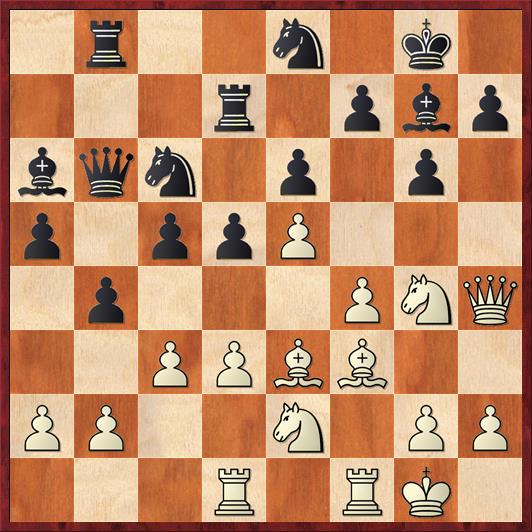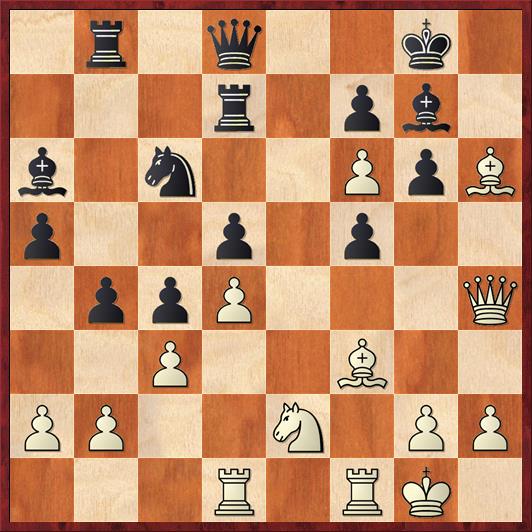Sometimes chess is about logic and finding the right moves. Other times, chess is about the things that sports are about: coping with adversity, finding opportunities, and exerting your will. That was the kind of game I played last night in the sixth round of the Kolty Chess Club Championship.
If you look at it with a computer, you’ll see a somewhat dubious speculative pawn sac by White, followed by a blunder by Black that basically ended the game. But from the viewpoint of psychology and will power, the story of the game was that I recognized that the position was heading in a direction I didn’t like, and radically altered the flow of the game so that my opponent had to find difficult moves rather than me. He failed the very first challenge, and that is part of the game. I did feel a bit lucky afterward, but this was clearly a case where fortune favored the brave.
I played White against Eric Steger in a Pirc that turned into a Grand Prix Sicilian. We’ll pick the game up after his 18th move.

FEN: 1r2n1k1/3r1pbp/bqn1p1p1/p1ppP3/1p3PNQ/2PPBB2/PP2N1PP/3R1RK1 w – – 0 19
Let me first say something about my general philosophy in the Grand Prix, and why I like playing it. Basically White throws his pawns and pieces at the kingside, and Black throws his pawns at the queenside. The computer generally says that the positions are equal. But White always has a little trump card, or an ace in the hole: the target of his attack is Black’s king, while the target of Black’s attack is just some pawns on the queenside. This always makes me feel that in games between humans, the so-called equality is not so equal. We’ll see that play out in this game.
Eric has just played 18. … b4, which I thought was an excellently timed move. He played it at a moment when I was not prepared to answer 19. c4. I spent a very long time on this position, more than 25 minutes. Most of that time was spent trying to get 19. Nf6+ to work, but it doesn’t because of 19. … Nxf6 20. ef Qd8. I looked at tons of other ideas: Qf2, Nh6+, b3, Rd2, etc. Finally I just said, “To hell with it, I will play the most assertive move,” and played
19. d4?! …
One of my mottos is: “Long think, wrong think.” When I take 25 minutes on a move, it’s almost certainly not the best. This morning the computer convinced me that 19. Nh6+ was the best move, but I was very reluctant to play that move last night, because I was still hoping to insert the knight into f6 eventually. Frankly, that was my answer to the Mike Splane Question: How am I going to win this game? And you’ll see that I was right!
The problem with 19. d4 is that Black can play 19. … Bxe2 20. Bxe2, followed by either 20. … c4 or 20. … bc with a good position. That’s one reason it took me so long to decide on this move. But Eric surprised me by almost instantly playing
19. … c4?!
With this move he chooses to lock in his own bishop rather than first trading it off. I don’t understand this decision, and thought it must be a mistake – which perhaps explains my rather impulsive followup.
20. f5!? …
This move is almost always “in the air” in the Grand Prix Sicilian. Strategically, it’s a fantastic move because it opens the c1-h6 diagonal for the bishop, opens the f4 square for the knight, takes the f5 square away from the opponent’s knight, and possibly opens the f-file for the rook. But the devil is always in the details. This move costs a pawn, so you have to consider carefully whether all of these other positional factors actually add up to compensation.
In this case, I wasn’t actually sure that I had compensation. But one thing I was sure of was that I didn’t want to sit around and defend my queenside with a move like Rd2, because sooner or later Black will penetrate along the b-file and the a2 and c3 pawns will be hard for White to hold.
So the choice was: a long and probably hopeless defense on the queenside, or an unclear attack on the kingside that at least will throw Black back on his heels and force him to defend. To me, it was a pretty clear choice.
20. … ef 21. Nf6+?! …
Rybka still likes 21. Nh6+ better and thinks that White is only down by 0.3 pawns.
21. … Nxf6 22. ef Qd8 23. Bg5 …
This was, of course, the point of the pawn sac 20. f5. White is now able to defend the “bone in the throat” pawn on f6. But, unfortunately, it’s not for long.
23. … h6 24. Bxh6 …

FEN: 1r1q2k1/3r1pb1/b1n2PpB/p2p1p2/1ppP3Q/2P2B2/PP2N1PP/3R1RK1 b – – 0 24
Of course I was expecting Black to play 24. … Bxf6, and was trying to work out whether to retreat my queen to h3, g3, or f2, when suddenly Eric startled me by taking the other way. The verdict on 24. … Bxf6 25. Qh3 is unclear, even after looking at it on a computer. Rybka starts with a +0.8 pawn evaluation in favor of Black, but when you play through some lines you’ll find some interesting tactics showing up and Black’s so-called advantage melting away.
This is where the sporting element of the game comes in, which I wrote about at the beginning. Black is probably objectively better, or at least equal. But he is the one who will be under pressure, forced to make difficult decisions. Meanwhile, White will be having fun, attacking the pawn on d5, playing g4, loosening up Black’s kingside, maybe invading on the f-file or sacrificing an exchange on e7. We’re playing the game that White wanted to play. Eric was obviously uncomfortable with this kind of position and from that point of view his blunder is much less surprising.
Earlier in the week Mike Splane gave me a “scouting report” on Eric, in which he said that he has never seen Eric sacrifice material. That tells me something. A person who never sacrifices material is a person who is not comfortable in a position with material imbalances, and he may not be as good at defending a position where he’s a pawn up but has a lot of things to worry about. I’m not sure whether this psychological profile is accurate, but it sure worked out well here.
24. … Qxf6?? 25. Bg5 …
Eric must have missed this move somehow. Now all of White’s pieces swing into position like clockwork.
25. … Qe6 26. Nf4 Qe3+ 27. Kh1 Re8?
The computer points out that Black can try 27. … bc! 28. Nxd5 Qxg5! 29. Qxg5 cb. White has to be very careful. The d4 pawn is a goner, so it will soon be a piece and three pawns against a queen, and those pawns on c4 and b2 could turn into monsters. However, remember the scouting report. It would be unlikely for a person who never sacrifices to find a queen sacrifice like 28. … Qxg5!
28. Nxd5 Qe6 29. Nf6+ Black resigns
Remember the Mike Splane Question? I thought all along that Nf6+ was going to be my winning move, and I even got to play it twice in one game. Of course 29. … Bxf6 30. Bxf6 leads to instant mate. And if 29. … Kf8 I was going to play 30. Rde1! Qxe1 31. Nxd7+ Kg8 32. Rxe1, winning a whole queen.
As I predicted last week, this win makes the last round of the tournament a whole lot more interesting. On board two, Paulo Santanna upset Mike Splane, so we now have a three-way tie for first between Eric, Paulo, and me, each with a score of 5-1. The pairings I would expect for the last round would be me against Paulo on board one, and Eric against the highest-rated player with 4½ points, who I think is Steven Svoboda. I suspect that Eric still has the upper hand in tiebreaks, so I have to play for a win and hope that Eric loses or draws. If Eric loses, it’s conceivable that I could win the tournament even with a draw against Paulo, but that would depend on the tiebreaks and I certainly would not want to count on it.



{ 5 comments… read them below or add one }
Was nice finally meeting you in person!
I want to highlight a couple of other participants to you: Alex Kourottchenko is 91(!) years old. He is +0-1=2 against me in what actually easily could’ve been +3-0=0 and was one move away from a brilliant victory this Thursday. Amazing longevity. Lev Feldman is 81 and still has the instincts – with the steady 4 out 6 in this championship.
Likewise I was glad to meet you! I’ve always enjoyed your comments on my blog. It’s nice to get feedback of any kind, but especially when it is thoughtful feedback that helps me learn something.
Indeed, it’s hard to miss Lev Feldman! He hasn’t lost a game in this tournament. In a tournament like this, where it will probably take 6 points out of 7 to win, you just hope that you won’t get paired against Lev because you probably aren’t going to get more than a draw from that game.
I don’t know which one is Alex yet. (Keep in mind, this is my first tournament ever at Kolty.) But if I’m still playing that well at age 91, I will be very happy.
Actually, I had a much easier time playing Lev (+3-0) than Alex
Here’s his last game’s fragment that I caught:
3r2r1/2q2pkp/p3p1p1/1p2P3/2bp1QN1/8/P4PPP/R2R2K1 w – – 0 1
He could force a draw, but chose to put pressure on his opponent with 1. a4! His opponent should’ve defended his leaky dark squares with Qe7, but he chose a sword duel instead with 1. … d3 2.axb5 d2?! probably thinking that after 3. Rd1 Be2? he’s forking the rook and the knight, ultimately removing the latter one from the play.
However Alex found a great riposte with a double Swischenzug:
4. Qh6+! Kh8 5. Nf6 Rg7 (computer recommends a triple Swischenzug with 4. b6!! but this one would be too much) 6. Rxd2, and suddenly the knight escaped the bishop and the tables have turned.
Now his opponent could’ve put a bit of resistance with 6. … Bxb5 although White’s pressure on the Black king should prove too much to handle. Instead he played 6. … Rxd2, and now Alex missed what could’ve been a contender for Chess Life combination of the month or something with 7. Nxh7!! and Black is mated at most in seven.
The automatic recapture 7. Qxd2 didn’t give the win away though. After 7. … Bxb5 the weakness of the back rank and the power of the knight on f6 would easily become decisive with a natural move 8. Rd1! (Rc1 also wins, but slightly more complicated)
Unfortunately, Alex finally saw the Kxh7 idea and quickly (which, amazingly, is his biggest problem at the age of 91 – what Russians call ???????? – you’re welcome to suggest an adequate translation) played 8. Qh6?? . After 8. … Qxe5 he stretched his hand for the knight, and then noticed that his rook was hanging with a backrank checkmate, and the game was quickly over…
If you want, I can send you a couple of PGNs of my games with Alex, they’re both a wonderful juggle of tactics.
The gobbled cyrillics were meant to say “shlepan’e” 🙂
CORRECTION (sorry for the spam): the FEN is incorrect. White’s rooks are on a1 and c1, not a1 and d1.